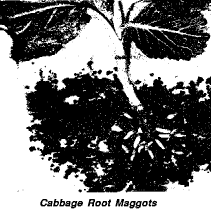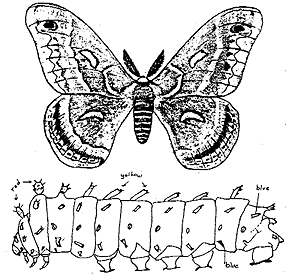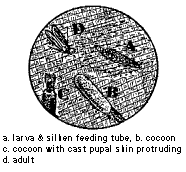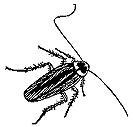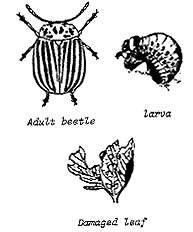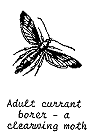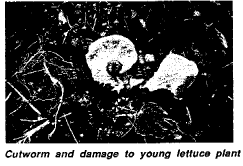|
|
|
INJURY: |
The adult flies emerge from the soil where they overwintered as pupae about the time the first crucifer plants are sent in the garden. The females either tuck the eggs down between the plant stem and the soil of transplants, or lay eggs in a recently planted field so that the young plant is attacked at emergence.
Eggs hatch in about 4 to 10 days and in about 3 weeks maggots are full grown. The pupal stage lasts 12-18 days and the adults emerge from the puparium. There may be four broods of cabbage maggot in New York. The first occurring in late April through May, depending on location in the state, the second in late June to mid-July, the third appearing in mid August and the fourth in the fall. Generally the first brood is the most destructive in upstate New York, however, on Long Island the trouble occurs for a longer period.
DESCRIPTION:
Cabbage maggot adults are true flies (Diptera) a little
smaller than the common housefly. They are seldom seen by home
gardeners. The adults are gray, long legged flies closely related to
the seed corn maggot. The larvae are white and legless, tapered
toward the head, and have a pair of black mouth hooks that curve
downward for rasping. The larvae pass to the puparium, a reddish or
tan capsule resembling a grain of wheat, in the soil near the
plant.
Back to Pest Information
|
Psilia rosae (F.) |
|
|
INJURY: DESCRIPTION: |
Flies begin to emerge from the overwintered puparia in mid-May and continue emergence into June. There is a pre-oviposition period of a few days following emergence, and then the females deposit small elongate white eggs in cracks and crevices of the soil adjoining the crowns of the young carrot plants. The eggs hatch in 7-10 days, and the young larvae move downward feeding on the fiberous roots. As they increase in size, larvae attack the taproot but because the roots are small at this time, they do not burrow into them, but instead girdle them about half way down. Young plants wilt and may die. If plants are not killed the resulting injury causes them to be forked, distorted and misshapen. The larvae feed for about a month, then enter the pupal stage. The pupal stage lasts about a month and the second generation flies begin emerging during late July, peaking in mid-August. Eggs are again deposited on the carrots (which are enlarging rapidly at this time) and the young larvae soon enter the carrot. They mine the cortex (outer layer) leaving meandering tunnels filled with rust-colored debris. Soil-borne root pathogens often invade these holes and decay starts soon after the insect injury. Second generation maggots mature, form pupae, and some will overwinter. A few, however, may hatch and emerge from October to late November. Commercially grown carrots are usually harvested before the third generation of larvae can occur, but in home gardens this may not be the case.
Back to Pest Information
|
Hyalophora cecropia |
|
|
DESCRIPTION: LIFE HISTORY: |
INJURY AND MANAGEMENT:
There is usually little damage from the larvae of the cecropia as
they do not occur in large numbers in any one locale. The larvae feed
on a variety of deciduous trees and shrubs including plants in the
Rosaceae family, willows, maples, and lilacs. The larvae do not bite
or sting despite their appearance.
Generally control is not necessary. There are a number of natural
predators and parasites that work together to keep populations of the
cecropia down. However, once in a while populations may be large
enough to cause damage.
Back to Pest Information
|
|
|
|
INJURY: |
The adult moths of these two species look very much alike. They are yellowish-tan to buff-colored with a wingspread of about 1/2 inch. The larvae are white with brown to black heads, and are also about 1/2 inch long. The casemaking clothes moth larvae spin a protective case out of silk and material fibers, often blending in with the fabric so damage is not noticed until a bare spot or hole is produced. The webbing clothes moth spins silk over the fibers it is feeding on but does not form a case around itself until ready to enter the pupa (resting stage).
LIFE HISTORY:
Female clothes moths deposit soft white eggs in clothing and
household furnishings. A single female may deposit from 100 to 300
eggs. Eggs hatch in one to two weeks during the summer or in heated
rooms, while in unheated rooms hatching may take longer. After
leaving the eggs, the tiny larvae begin feeding and soon begin to
spin some silk either for a case or as webbing over the fabric. The
amount of time it takes for a larva to mature varies greatly, from
about 40 to over 200 days. The pupa also occurs in the larval feeding
area and usually takes between 1 and 4 weeks. Adults emerge from the
pupae mate and begin the cycle again.
Clothes moths are often found in dark places. They dislike
sunlight and are not attracted to artificial light. They may be seen
fluttering about in darkened corners or at the edge of a circle of
light. When the items on which they are resting are moved, they
either run for cover or fly to a darker area to conceal themselves.
Infestations often start when woolens are improperly stored in dark
places and left undisturbed for long periods of time.
Back to Pest Information
|
|
THE INSECT AND ITS BEHAVIOR:
The cluster fly (Pollenia rudis) is a past in homes, schools, hospitals and commercial buildings throughout much of New York and surrounding states. It is found in areas where conditions of soil, growing plants and climate support populations of a small earthworm known scientifically as Allolobophora rosea. The larvae of cluster flies feed upon these earthworms during summer months. As days lengthen and fall approaches adult flies emerge from the soil and seek out secluded places to hibernate. They hide beneath the loose bark of trees, in stone walls, or in plant debris. They also enter buildings wherever they find opportunities. Flies that over-winter successfully emerge from hibernation sites in the spring to breed and lay eggs on the surface of the soil near earthworms upon which their young can feed. The breeding cycle is repeated three or four times each year.
Cluster flies hibernating in buildings seek the seclusion of
between-wall spaces, window frames, attics and other voids. They may
be stimulated by warmth to resume activity shortly after entering, or
at any time until spring weather lures them outdoors to resume their
natural behavior. Thus from mid-August to April cluster flies, warmed
within a building, may be attracted by windows or lights to occupied
rooms, creating a serious nuisance
Back to Pest Information
|
|
|
|
INJURY: Cockroaches feed on a variety of foods, with a preference for starchy and sugary material. Cockroaches will sip milk, soda or beer left out or left in unrinsed bottles, nibble cheese, feed on meats, pastry, grain products, sugar&emdash;practically all the foods that we eat. They will also feed freely on book bindings, sizing, innerlinings of shoe soles and dead insects. They carry debris on their legs and bodies and may spread germs and contaminate food. Cockroaches also give off an offensive odor that may ruin food, or may persist on dishes or other items the roaches run over. |
There are four types of house-infesting roaches that are commonly seen in New York State. These are the American cockroach, brown-banded cockroach, German Cockroach and Oriental cockroach. Cockroaches have a broad, flattened shape and six long spiny legs. They are dark brown, reddish-brown, light brown or black and the adults of most species have wings. The following describes the roaches and their habits:
|
| ||
|
|
|
|
|
American Cockroach |
Reddish brown to dark brown |
Develop in damp basements & sewers; forage mostly on
first |
|
Brown-banded Cockroach |
Light brown. Mottled, reddish- brown wings on female; lighter wings on male. |
Develop and live all over the building. Adults 5/8 inch long. |
|
German Cockroach |
Light brown. Black stripes runninglengthwise on back. Adults 5/8 inch long. Most common of the four kinds. |
Develop & live all over the building, particularly in kitchens and bathrooms. |
|
Oriental Cockroach |
Black or dark brown. Traces of wings on females; short wings on males. Female adults 1 to 1 1/4 inches long; male adults a little Shorter. More sluggish than other three kinds. |
Develop in damp basements & sewers; forage mostly on first floors of buildings. |
LIFE HISTORY:
Cockroaches undergo a gradual metamorphosis which means that there are three stages in their development, egg - nymph - adult. The young nymphs resemble the adults but they are smaller and have no wings.
Cockroaches hide during the day in sheltered places. They come out
to look for food at night, and if disturbed, run rapidly for shelter
and disappear through openings to their hiding places. Some typical
hiding places for roaches include warm, dark, moist places such as
under a sink, behind a dishwasher, stove, refrigerator and upper
cupboards.
Back to Pest Information
|
Leptinotarsa decemlineata |
|
|
DESCRIPTION: Adult potato beetles are yellow and have ten black longitudinal stripes on their wing covers, and are about 3/8 inch in length. The larvae (or slugs as they are sometimes called) are brick red in color, hump-back, soft bodied and are a bit more than _ inch in length when full grown. They have two rows of black spots on either side of the body. Eggs are orange-yellow in color and laid in clusters on the underside of the leaves. INJURY: |
Adult beetles come out of winter hibernation in mid-May on Long Island and a week or ten days later in central New York just before the early planted potatoes are up. Clusters of 20 or more eggs are laid on the underside of the leaves soon after the beetles emerge. The eggs hatch in 7 to 9 days. The larvae feed on the foliage, grow rapidly and complete their development in 18 to 21 days. The full grown larva burrows into the ground and changes to the pupa or resting stage. After 7 - 10 days the adult beetle emerges from the pupa, crawls up out of the ground, and after a short period of feeding, lays eggs for the second generation.
Back to Pest Information
|
Synanthedon tipuliformis |
|
|
The currant borer is a destructive insect pest which has been known to become so abundant in some gardens that the raising of currants may be abandoned for a time. In addition to currant, it may attack gooseberry, black elder and sumac. DESCRIPTION: The larva, which is the damaging stage, is whitish with a brown head and legs. It is found in the pith of the stems of the currant plant. |
In June the females deposit brown globular eggs singly on the bark of younger stems of the host plants. Upon hatching the tiny larva bore into the stem and burrow through the center. By the end of summer the 1/2" (13mm) larva is nearly full grown, and it is this nearly mature caterpillar that overwinters.
The following May the larva burrows toward the surface of the stem, forming a silk-lined hole just below a thin layer of bark, and pupates there. When the adult is ready to hatch the pupal case is pushed part way out of the stem and the adult moth emerges leaving the empty pupal skin projecting from the hole. There is only one generation per year.
DAMAGE:
The caterpillar causes the injury by feeding on the pith of the stem.
Infested canes do not die in the fall, but put out a sickly growth
the following spring. Larval feeding prevents the movement of
adequate amounts of water and nutrients, and the canes eventually
die.
Back to Pest Information
|
|
|
|
DESCRIPTION: There are many species of cutworms and each differs somewhat in appearance. Many of the more common species are stout, soft bodied, smooth and cylindrical larvae. The color ranges from brown to gray to black. Cutworms may be either spotted or striped, or may have no particular markings at all. The adult moths are robust, dull-colored moths, sometimes called millers, which fly only at night. |
Cutworms feed on a great variety of plants. In the home garden they may cause severe damage in one of the following ways: (1) surface cutworms eat off plants near the soil surface, (2) climbing cutworms climb plants and eat leaves, fruit, etc., or (3) army cutworms occur in great numbers and consume nearly all the foliage of the plants, or (4) subterranean cutworms remain in the soil to feed upon roots and underground stems. Cutworms feed at night and hide in the soil or under piles of debris during the day.
LIFE HISTORY:
Some cutworms overwinter as partly grown larvae, although a few
overwinter as pupae. They find shelter in the soil, under clumps of
grass, or under piles of debris. In spring as the warm weather
arrives, the cutworms begin feeding. In early summer, the mature
cutworm hollows out a chamber in the soil and transforms to the pupal
or resting stage. For the species that overwinter as pupae, the adult
moths emerge in early spring and the egg laying begins at that time.
Pupae change to moths and the moths crawl out of the soil. Another
generation begins as the females start to lay eggs in last summer on
the stems of plants or the soil surface. One female is capable of
laying from a few hundred to 1500 eggs. Eggs hatch after a few days
to two weeks and the larvae feed until cold weather arrives
Back to Pest Information

|
This site is developed and administered by Lake Technology Solutions, Inc. | www.LakeTS.com | (888) 332-8082 |
